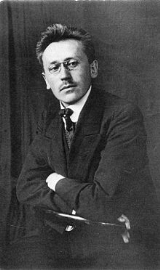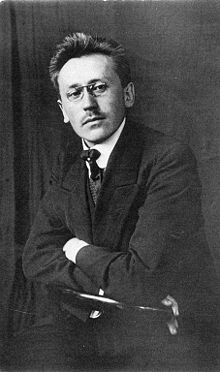
Armas Launis
Encyclopedia

Finland
Finland , officially the Republic of Finland, is a Nordic country situated in the Fennoscandian region of Northern Europe. It is bordered by Sweden in the west, Norway in the north and Russia in the east, while Estonia lies to its south across the Gulf of Finland.Around 5.4 million people reside...
composer
Composer
A composer is a person who creates music, either by musical notation or oral tradition, for interpretation and performance, or through direct manipulation of sonic material through electronic media...
as well as an ethnomusicologist, a professor, a writer and a journalist. He was born in Hämeenlinna
Hämeenlinna
Hämeenlinna is a city and municipality of about inhabitants in the heart of the historical province of Häme in the south of Finland and is the birthplace of composer Jean Sibelius. Today, it belongs to the region of Tavastia Proper, and until 2010 it was the residence city for the Governor of the...
.
The Composer
Armas Launis was mainly an opera composer. He wrote 10 operas (both libretto and music). Several were performed:- In Finland: "The Seven Brothers" (1913), the first Finnish opera comique, and "Kullervo" (1917), both in full stage performance, and a concert performance of "Aslak Hetta" in 2004 at Finlandia HallFinlandia HallFinlandia Hall is a concert hall with a congress wing in Helsinki, Finland, by Töölönlahti bay. The building was designed by Alvar Aalto. The work began in 1967 and was completed in 1971.-Design and building:...
, HelsinkiHelsinkiHelsinki is the capital and largest city in Finland. It is in the region of Uusimaa, located in southern Finland, on the shore of the Gulf of Finland, an arm of the Baltic Sea. The population of the city of Helsinki is , making it by far the most populous municipality in Finland. Helsinki is...
, directed by Sakari Oramo. - In FranceFranceThe French Republic , The French Republic , The French Republic , (commonly known as France , is a unitary semi-presidential republic in Western Europe with several overseas territories and islands located on other continents and in the Indian, Pacific, and Atlantic oceans. Metropolitan France...
: stage performance of Kullervo (1940, Nice, Palais de la Méditerranée) with radio broadcasts on Paris-Inter and Radio Monte-Carlo (1938–1940). A short version of "Jehudith" was also broadcast in 1954 (Paris-Inter)
Armas Launis also wrote chamber music pieces, cantatas, choruses, suites for orchestra and the music of the first Finnish ethnographic film "A wedding in Karelia, the land of poetry" (1921).
The ethnomusicologist
Launis was one of the first scholars to collect and do research on folk music. He was very open-minded, passionately fond of travels which he undertook alone, eager to meet other people and to listen to them. He travelled to Lapland (1904, 1905, 1922), to KainuuKainuu
Kainuu is a region of Finland. It borders the regions of Northern Ostrobothnia, North Karelia and Northern Savonia. In the east it also borders Russia. Kainuu is known in the ancient Norse sagas as Kvenland....
(1902), to Ingria
Ingria
Ingria is a historical region in the eastern Baltic, now part of Russia, comprising the southern bank of the river Neva, between the Gulf of Finland, the Narva River, Lake Peipus in the west, and Lake Ladoga and the western bank of the Volkhov river in the east...
(1903, 1906), Karelia
Karelia
Karelia , the land of the Karelian peoples, is an area in Northern Europe of historical significance for Finland, Russia, and Sweden...
(1902, 1905) and Estonia
Estonia
Estonia , officially the Republic of Estonia , is a state in the Baltic region of Northern Europe. It is bordered to the north by the Gulf of Finland, to the west by the Baltic Sea, to the south by Latvia , and to the east by Lake Peipsi and the Russian Federation . Across the Baltic Sea lies...
(1930). Everywhere, he was happy to meet local people, had long conversations with them, jotting dowwn popular melodies, also recording famous singers, hired mourners and kantele players. Launis understood the richness and vitality of sung poetry together with the importance of folklore. His numerous publications and the corpus he collected are still being recognized and used nowadays and are valuable additions to the common inheritance of the nation.
Later, he travelled and stayed in North Africa, got interest in Arabic, Berber and Bedouin music. This influence can be felt in later works, especially the operas Théodora and Jéhudith.
The Professor
Armas Launis had a PhD (1911) and was full Professor at the University of Helsinki where he taught musical analysis and composition. He completed his studies in BerlinBerlin
Berlin is the capital city of Germany and is one of the 16 states of Germany. With a population of 3.45 million people, Berlin is Germany's largest city. It is the second most populous city proper and the seventh most populous urban area in the European Union...
with Wilhelm Klatte and in Weimar
Weimar
Weimar is a city in Germany famous for its cultural heritage. It is located in the federal state of Thuringia , north of the Thüringer Wald, east of Erfurt, and southwest of Halle and Leipzig. Its current population is approximately 65,000. The oldest record of the city dates from the year 899...
with Waldemar von Baussenern. Deeply concerned with the opening of musical education for everyone, he founded the first popular conservatories in Finland which still exist and that he directed until 1930.
As early as 1920, he received a life pension from the Finnish State with the permission to live abroad.
The journalist
Being anxious to maintain contact with his homeland, Launis was a regular contributor to various Finnish newspapers (Helsingin SanomatHelsingin Sanomat
Helsingin Sanomat is the largest subscription newspaper in Finland and the Nordic countries, owned by Sanoma. Except after certain holidays, it is published daily. In 2008, its daily circulation was 412,421 on weekdays and 468,505 on Sundays...
, Uusi Suomi
Uusi Suomi
Uusi Suomi was a Finnish daily newspaper, which was published from 1919 to 1991.On May 25, 2007, it was announced that the Finnish company Nikotiimi had purchased the rights to the name "Uusi Suomi" from Alma Media and would start an online newspaper bearing that name in the fall of...
, Suomen Kuvalehti
Suomen Kuvalehti
Suomen Kuvalehti is a weekly Finnish magazine, published by Otava every Friday. The magazine has a circulation of 101,000 and its editor is Tapani Ruokanen. Suomen Kuvalehti aims to write broad articles about current topics.The comic strip Blondie regularly appears in the magazine...
). He co-founded and was an active member of the Sociéte de la presse étrangère de la Côte d'Azur (Association of foreign press of the French Riviera) and a journalist for the Association française d'expansion et d'échanges artistiques (French Association for the development of artistic exchanges).
In 1930 he settled permanently in Nice
Nice
Nice is the fifth most populous city in France, after Paris, Marseille, Lyon and Toulouse, with a population of 348,721 within its administrative limits on a land area of . The urban area of Nice extends beyond the administrative city limits with a population of more than 955,000 on an area of...
, France, where he died; he took an active part in musical and cultural exchanges between France and Finland.
Operas
- The seven brothers (1913)
- Kullervo (1917)
- Aslak Hetta (1922)
- The witch's song (1934)
- The Karelian scarf (1937)
- The summer that never came (1936)
- Jehudith (1937–1940)
- Once upon a time (1939)
- Theodora (1939)
- Frozen flames (1957)
Books
- Über Art, Entstehung und Verbreitung des estnisch - finnischen Runenmelodien (1910)
- Ooppera ja puhenäytelmä:muutamia vertailevia piirteitä (1915)
- Esivanhempieni muisto 1500-1900 (1921)
- Aslak Hetta: 3-näytöksinen ooppera (libretto 1921)
- Kaipaukseni maa. Lapinkävijän muistoja (1922)
- Murjaanien maassa (1927)
- Suomen maaseutukaupunkien kansankonservatoriot (1927)
- Erään turunmaalaisen saaristolaisuvun vaiheita (1929)
- Tunturisävelmia etsimässä. Lapissa 1904 ja 1905. (Minna-Riikka Järvinen 2004)
Corpus of melodies
- Lappische Juoigos-Melodien (1908) (Lappish melodies)
- Suomen Kansan sävelmiä IV: Inkerin runosävelmät (1910)
- Suomen partioväen laulukirja (1917)
- Suomen Kansan sävelmiä IV: II Karjalan runosävelmät 1930
- Eesti runoviisid (Tartto 1930)
Articles
- Runosävelmistä (Kalevalanseuran vuosikirja I, 1921)
- Kullervo-oopperan esihistoriaa (Kalevalaseuran vuosikirja 1, 1921)
- Saamein säveleitä etsimässä (Kalevalaseuran vuosikirja 2, 1922)
- Muuan karjalainen kanteleensoittaja (Kalevalaseuran vuosikirja 1923)
Sources
- Ahmajärvi, Jouni 2003" Se maa on taikamaa, on maa mun kaipauksen" Armas Launiksen kuva Lapista ja saamelaisista. Julkaisematon pro gradu-tutkielma Oulun yliopisto,Historian laitos.
- Fantapié, Henri-Claude 2000: Armas Launis(1884–1959): un compositeur finlandais dans le contexte niçois et français. Boréales 2000: 78/81, p. 213-230. http://www.solistesdeparis.com
- Fantapié, Henri-Claude 2003: Quand un compositeur du Nord croise un collègue venu du Sud.... Boréales 2003 86/89, p. 249-263.
- Hako, Pekka 1982: Armas Launis 1884-1959-Felix Krohn, Armas Launis, Ernst Linko.Hämeen läänin taidetoimikunta, Hämeenlinna.
- Hako, Pekka 2004:Armas Launis:opera composer. Finnish music quarterly 2004:2, s. 42-47.
- Heinonen, Kati 2005: Armas Launiksen fonogrammit Soikkolasta: laulutavan,runon ja laulutilanteen välisiä yhteyksiä kalevalamittaisessa runoudessa. Pro gradu-tutkielma http://ethesis.helsinki.fi/julkaisut/hum/kultt/pg/heinonen/.
- Jouste, Marko 2004: Armas Launiksen vuoden 1904 Lapin matkan joikusävelmien keräys ja soiva vertailuaineisto. Musiikin suunta 2004:2,s.58-81.
- Järvinen, Minna Riikka 2004: Ummikkona Pohjan perille. - Launis, Armas: Tunturisävelmiä. Lapissa 1904 ja 1905. Toim. Minna Riikka Järvinen. Helsinki: SKS, 341-351.
- Tomasi, Henri 1940: Armas Launis. Notes biographiques. Kullervo. Autres oeuvres. Préface H.Holma. London.
- Väisänen, A.O. 1960: Armas Launis 1884-1959. Kalevalaseuran vuosikirja 40, s. 345-349.
- Tarasti, Eero, Muotokuvia, Imatran Kansainvälisen Semiotiikka-instituutin julkaisuja, nr.3
See also
- On the Website of Finland's Musical Information Center, keyword: "Armas Launis"
- Numerous relevant data will be found http://www.fimic.fi

